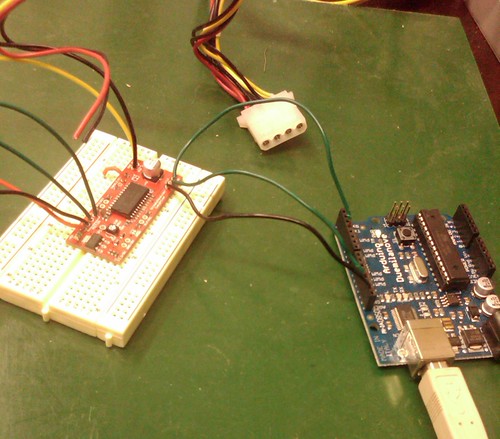- Mon Nov 23, 2009 9:15 am
#85705
I'm trying to get an 8 wire stepper motor hooked up to the easy driver v4. Here's the story.
After pouring over tons of web pages and trying to figure out exactly how steppers work, I think I’ve narrowed it down to three possibilities. However, I have no idea if I’m correct. For all I know, this could be completely wrong. If anyone knows the right way to do this *PLEASE* let me know.
Overview:
I turned my mulit-meter so when I touch the two probes together, they beep. (continuity mode?)
Then, I went through all the pins, and this is how they line up:
Pin 1 + Pin3 = Beep
Pin2 + Pin4 = Beep
Pin5 + Pin7 = Beep
Pin6 + Pin8 = Beep.
Option1: Take one wire from each pair, twist them together and connect all 4 of them to M+, use the other 4 wires to connect to A,A,B,B on the EasyDriver
Option2: Twist the pairs together, connect the 4 pairs to A,A,B,B on the EasyDriver
Option3: Take one wire from each pair, do not connect to anything, take the other 4 wires and connect to A,A,B,B.
As you can tell, I’m a complete noob, so seriously any help, as rudimentary as it may seem to you, would be greatly appreciated.
Thanks in advance,
Edward
After pouring over tons of web pages and trying to figure out exactly how steppers work, I think I’ve narrowed it down to three possibilities. However, I have no idea if I’m correct. For all I know, this could be completely wrong. If anyone knows the right way to do this *PLEASE* let me know.
Overview:
I turned my mulit-meter so when I touch the two probes together, they beep. (continuity mode?)
Then, I went through all the pins, and this is how they line up:
Pin 1 + Pin3 = Beep
Pin2 + Pin4 = Beep
Pin5 + Pin7 = Beep
Pin6 + Pin8 = Beep.
Option1: Take one wire from each pair, twist them together and connect all 4 of them to M+, use the other 4 wires to connect to A,A,B,B on the EasyDriver
Option2: Twist the pairs together, connect the 4 pairs to A,A,B,B on the EasyDriver
Option3: Take one wire from each pair, do not connect to anything, take the other 4 wires and connect to A,A,B,B.
As you can tell, I’m a complete noob, so seriously any help, as rudimentary as it may seem to you, would be greatly appreciated.
Thanks in advance,
Edward






